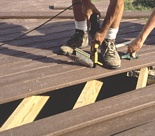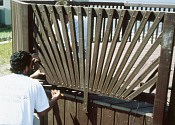
Try TREX for decks by Mike Mangan
In 2001 I purchased a model home from a local builder in a far northwest suburb of Chicago—a great getaway from the big city—but the home wasn't complete. I always wanted a deck and having a backyard view of the local park and retention basin seemed like the ideal setting, so I set out to research decking material. Pressure-treated timber was the least expensive, and cedar and redwood were options, but I wanted to build with a product that would look good year after year, add value to the home, and be maintenance-free. Alternative building materials such as plastics and wood-composites caught my attention. Several companies offer materials in this area so after poring through literature, checking samples, and talking to individuals who had experience with these products, I decided to go with TREX. 
Photo 1 This particular decking product has a track record of over 10 years. What's different about TREX is its wood-polymer combination. By weight, 50 percent of TREX consists of wood fibers. It's environmentally friendly because it also contains the same plastic bags retailers stock to package goods. Recycled, these plastic bags get a second life rather than clogging the nation's landfills, so I was still getting a decking a material that had some wood qualities but not the maintenance associated with it. TREX offers impressive features: it requires no sealants or weatherproofing; does not splinter or crack; will remain undamaged by rot or termites; experiences minimal shrinking or swelling from moisture; and is slip-resistant. TREX also cuts, fastens, sands, and paints easily and features natural UV resistance; however, if you are purchasing maintenance-free decking material, you probably don't want to paint it—it defeats the purpose. Another advantage of the wood composite material is that it offers a 10-year warranty. Not only is TREX used for home decks, but many beach-side communities also use it, for example, the Everglades National Park has a TREX walkway. The Presidential Trail at Mount Rushmore also incorporated TREX. I started looking through books and visiting Web sites for deck designs, but I just couldn't find what I was looking for. I got lucky—just down the block a neighbor had a cedar deck built with an octagon and a gazebo at opposite ends, a popular design because it separates eating and resting areas from the rest of the deck. The local home center had a similar plan with a single octagon off one corner. That ultimately was the catalyst for my deck's design, which was sketched and laid out by the builder. Its final overall size came to 33 1/2;' long x 12' deep, including a 12-foot octagon off the far right corner from the patio door to serve as a dining area (Photo 1). Ultimately, I plan to install a cover over the eating area like a pergola or an umbrella for a little shade. If you plan to hire a pro- fessional to construct this deck, then it's important to do your homework to get an idea of your proposed deck's design and size. Then, when you solicit bids from three contractors (which I recommend), you'll be able to give the same input to each contractor. However, be open to their ideas—with three different contractors involved, you are bound to get some suggestions from them. The next phase was to find the right deck builder. I ending up selecting one who had a great portfolio. He's been building decks for 15 years and was a hands-on contractor—he's worked on every deck he ever built. What impressed me the most was the fact that he believed in using screws rather than nails for greater holding power. His Midwest work ethic and attention to detail made him the ideal choice for my project. You'll discover as you seek bids that not every contractor and/or deck builder has experience with alternative decking material. Ideally, it would be best to hire one who has experience, but there are so many alternative materials on the market that the likelihood of finding an installer who has worked with all these products is pretty slim. It is also possible that he or she has experience with alternative decking materials and will recommend one product over another because of its ease of installation, warranty, and small number of callbacks. Whatever the case, it's important that your contractor research the product by contacting the dealer or manufacturer to learn the construction details involved with the chosen alternative decking material. Here are some requirements when using TREX for a decking project: 
Photo 2 Work with your local building department as you plan your deck; there are relevant codes, and permits will most likely be required. The code in our area dictates that 42" (minimum) holes be dug for the deck's footing. A power auger and post-hole digger worked well in our clay-based soil. The joists for the deck's foundation were set at 12" on center. Treated lumber was used to build the deck's undercarriage—which includes joists, ledger, rim, posts and beam—because TREX is not designed for structural use (Photo 2). While TREX can span 16", I recommend you stay 12" on center to prevent any flex in the decking board between the joists on a hot day. Blocks nailed between the joist help to stabilize the entire system from movement; however, our contractor did not install any framework blocking. Consider using ground cover (4-mil black plastic sheeting) beneath the deck's joists to curb pesky weeds and other vegetation growth. 
Photo 3 Gapping TREX decking is important. We used a Deck-Mate gapping tool to set up the decking boards at 3/16", but you can gap as much as 1/4". For boards up to 16' long, allow a 1/16" end gap for every 20º F difference between the temperatures on the day you install TREX decking and the highest temperature expected during the year. Use a carbide-tipped blade for smooth cuts in TREX. Because of TREX's flexibility, it is important to support it while making cuts. Before making cuts, determine the overhang (if any) and precut the first couple of decking boards up against the house where you will be unable to use the saw (Photo 3). 
Photo 4 When fastened with screws (Photo 4), TREX will pucker, yielding a mushroom-like effect. To reduce the pucker, set the screw gun so the screw is slightly recessed below the board's surface. A slight tap with a rubber mallet will bring the pucker flush to the surface. Using spray silicone will help to reduce friction as you drive screws; better yet, predrill for screws. The TREX decking was laid diagonally. As stated in the TREX contractor's handbook, a diagonal or herringbone layout requires 12-inch joist spacing for greater support. Decking board was sized and measured for the deck's skirting and screwed to the frame for a snug fit. Depending on the material used, skirting may be applied before or after the decking material's installation. 
Photo 5 TREX was used for the railing system, which includes balusters, top and bottom rails, and posts. Deck balusters (2 x 2) were cut and prepositioned prior to installation. The deck's baluster and top rail were positioned and screwed into the subframe. The decking was cut flush with the skirting because the balusters and posts were fastened directly to the skirting. An easy-to-construct starburst (Photo 5) accents any deck. Depending on the size of the deck, more than one can be incorporated into the design. Created using 2 x 2s, this starburst encompasses one side of the deck's octagon and is evenly spaced and screwed into the bottom rail. Watch your code requirements; the bottom rail of the starburst cannot be more than 4" off the deck and the maximum spacing between balusters is also 4". At the time my deck was under construction, my neighbor was talking about putting another coat of stain on his cedar deck. All I have todo is take out the garden hose, attach the spray nozzle, and hose down the TREX. It stills looks as good as the day it was originally installed. We hope this article with its 5 full-color photographs has answered most—if not all—of your questions about TREX. If you require further information, visit the company's website and contact them directly. Asktooltalk.com is unable at this time to respond to any telephone or email questions about TREX nor can we provide you with a phone number. You may also be interested in the following deck-related products available on asktooltalk.com: "Building decks" by Leon A. Frechette, a free article that discusses deck products, usage, and tips to design and build your deck. Click here! "Have confidence in treated wood" by Leon A. Frechette discusses wood treated with new-generation preservatives: copper azole (CA) and alkaline copper quaternary (ACQ). If you're concern about living with your existing outdoor structures made of wood treated with CCA (Chromated Copper Arsenate), this article also provides useful advice. To learn more about living and working with treated wood, click here! Copyright © 2003, 2005, & 2006 LAF/C.R.S., Inc. and Mike Mangan. Looking for home improvement Q&As? Click here! [ Back to Top ]
|
C.R.S., Inc. · Spokane, Washington · USA
Copyright © 1998-2021 by C.R.S., Inc. and asktooltalk.com
